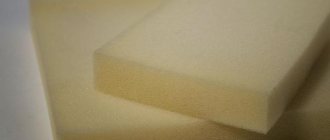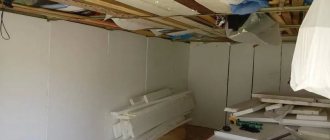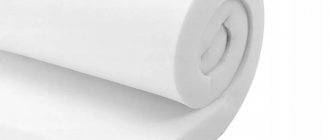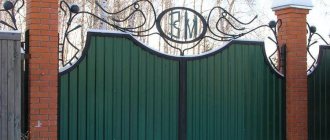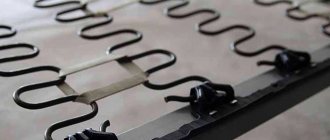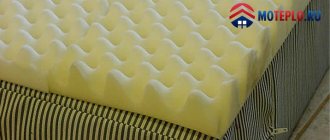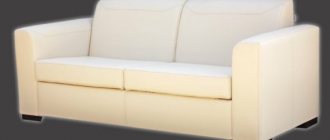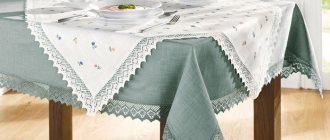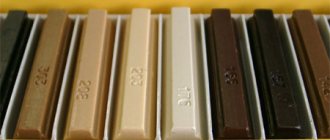Slowly, but Russians are still saying goodbye to small-sized apartments in Khrushchev-era buildings, where a 3-room apartment is often smaller in area than a modern one-room apartment. More and more large private houses are appearing. At the same time, we are talking not only about cottages in elite villages. As the living space increases, heating costs also increase. Proper thermal insulation of all structural elements of a building can save household finances, and therefore homeowners approach the choice of insulation very responsibly. After all, the slightest mistake is fraught with unpleasant consequences in the future.
Taking into account the increased attention of consumers to the topic of thermal insulation materials, the editors of the StroyGuru website have prepared a series of articles about modern types of insulation materials, their characteristics, advantages and disadvantages, and the best manufacturers. In this work we will tell you everything about polyurethane foam insulation, its liquid version, which among builders is called for short - polyurethane foam.
What is polyurethane foam
A new type of insulation for Russia, polyurethane foam, is rapidly expanding its niche in the construction market. Poor knowledge of the characteristics of the material, aggressive advertising by manufacturers and anti-advertising of competitors have led to the fact that this material is full of myths and conjectures, among which not only ordinary consumers, but also professional builders are lost.
This is what foamed two-component polyurethane looks like.
The problems start with terminology. By polyurethane foam insulation, many understand foam rubber, familiar to everyone from childhood. But this is a soft and very elastic type of polyurethane foam, which can be used to insulate entrance doors in a building, but not structural elements. Real insulation is in liquid form.
But even here, consumers and experts make inaccuracies, considering simple polyurethane foam to be the same as polyurethane foam insulation. At first glance, they are right: both materials are made of polyurethane foam. But there is still a significant difference. PPU insulation consists of two components: “A” - polyol and “B” - polyisocyanate. When mixed, they enter into a polymer synthesis reaction with the release of carbon dioxide. The result is a foamed material with a rigid structure and closed cells. Polyurethane foam can be purchased in barrels or pre-filled cylinders.
Polyurethane foam consists of one component, which, when exposed to air, comes into contact with water vapor (which is why there is a recommendation to wet the surface before applying foam) and polymerizes with oxygen, creating open cells of frozen foam. Hence the completely different physical and technical indicators. To make it clear what we are talking about, we present a table with the main characteristics of the materials.
Table 1. Main indicators of polyurethane foam and polyurethane foam.
| Types of polyurethane foam / Indicators | PPU | Polyurethane foam |
| Thermal conductivity, W/(m×°K) | 0,022-0,035 | 0,025-0,045 |
| Number of closed cells, % | More than 90.0 | Less than 50.0 |
| Change in foam volume compared to the beginning of the expansion process | 1 in 40 | 1 to 70-90 |
| Vapor permeability, mg/(m*h*Pa) | 0,02-0,05 | 0,07-0,17 |
| Density, kg/m3 | 20,0-80,0 | 8,0-18,0 |
| Moisture absorption,% | 1,0-3,0 | 10,0-60,0 |
| Compressive strength, kgf/cm2 | 1,53-10,19 | About 1.02 |
| Bending strength, kgf/cm2 | 3,3-19,37 | About 17.0 |
One type of polyurethane foam is polyurethane foam.
The next myth is that the insulation is new, little studied. Therefore, it is better to give preference to a well-tested, albeit not the best, heat insulator.
Indeed, in Russia this type of insulation began to be used only in the mid-90s of the last century. It is finding its niche with difficulty, since consumers still prefer traditional insulation materials: expanded clay, glass wool and basalt fiber wool.
The late appearance of PPU in the CIS countries does not at all mean that it appeared in the countries of Europe and North America at the same time. There it has been known since the late 30s of the 20th century (invented by the German chemist Otto von Bayer). Today, the lion's share of the insulation market in the USA and Europe is occupied by two-component polyurethane foam.
On the issue of determining the quality of the composition
When working, it is very important to use the correct product components manufactured by trusted companies. There are many fakes and not all manufacturers follow the recipe. This is why it is so important to work with one contractor and establish serious incoming controls.
The statistics are disappointing - in Russia, about 80% of supplied polyurethane foam is not adapted to the climatic conditions of the country. This suggests that the required insulation values will never be achieved, and the rate of erosion will greatly increase.
When working with polyurethane foam, you must not only be guided by the listed documents and requirements, but also request an additional set of papers from the contractor. Among them are the following:
- Data from "cup tests" to determine apparent foam density.
- Apparent density parameters for already sprayed polyurethane foam.
- A protocol drawn up based on the results of testing for the level of thermal conductivity.
- Recorded adhesion test data.
- Protocol indicating water absorption level testing data. Information about the level of vapor permeability established during the inspection and included in the officially certified protocol.
- The package of documents is supplemented with certificates - fire, hygiene, and compliance. A quality certificate is also requested.
We recommend requesting a price list indicating the cost of the mixture components in rubles, and not in conventional units, as unscrupulous contractors do.
Characteristics
There is also no clarity about the characteristics of the material.
Thermal conductivity
When advertising their products, sellers indicate very low thermal conductivity values of polyurethane foam. Rarely, you can find a coefficient of 0.017 W/(m×°K), more often - 0.020-0.022 W/(m×°K). But this is from the realm of fantasy. Even in laboratory conditions, where all requirements for the quality of components and their formulation can be met, it is rarely possible to obtain a thermal conductivity index of 0.022 W/(m×°K).
Similar values are achieved only with the use of freon r141b as a foaming agent, which is prohibited for use in Europe (and therefore is not produced). The use of other foaming agents increases the value of the coefficient, and therefore in European countries a thermal insulation layer with a thermal conductivity of 0.028 W/(m×°K) is considered high quality.
In Russia, the real figures are 0.030-0.035 W/(m×°K) (the specific value depends on the experience of the performers).
However, consumers should not be upset. Even if the technology is violated, the actual thermal conductivity of the insulation deserves respect, since it is one of the best and comparable to basalt wool.
Density
The density of the insulation determines the bending strength (fragility), the weight load on the structure and the thermal insulation properties.
Two-component, closed-cell polyurethane foam, can be obtained in different densities, combined into 3 groups.
- 1 group. Low density - 28-32 kg/m3. The main scope of application is ceilings and walls from inside the room, onto which the material is applied in a thin layer. Thermal conductivity coefficient is from 0.028 to 0.032 W/(m×°K). Vapor permeability at the wood level is 0.05 mg/(m*h*Pa), which makes it possible, albeit conditionally, after detailed calculations, to use polyurethane foam for insulating the walls of wooden houses (more on the problem below).
- 2nd group. Average density - 32-40 kg/m3. A classic representative of the species. The components are sold separately, in cylinders. Used to insulate all structural elements of a building. It has the lowest percentage of moisture absorption among all types of insulation.
- 3rd group. High density - 40-80 kg/m3. Achieving such density using portable equipment is theoretically possible, but practically impossible. It is used in places with high mechanical load on the heat-insulating layer, but only after special surface treatment, which experts call armoring.
Life time
Manufacturers of polyurethane foam consider their products to be durable, with a service life of 30-50 years. These figures are confirmed by the experience of using this insulation in the USA and Europe. However, in Russia, in the first years of using the new product, they were faced with the fact that the insulation from the facades of multi-storey buildings began to fall off in layers after 5-6 years of operation.
At first, the root of the evil was seen in the poor adhesion of polyurethane foam to the wall material. When the lag became widespread, they began to study the problem seriously and turned to Western experience. It turned out that the reason is in a completely different plane - the sun's rays. The material does not tolerate ultraviolet irradiation, ages, or in the language of scientists: it is subject to UV destruction. The aging rate is about 1 mm per year.
The worst enemy of polyurethane foam is the sun.
Simply painting the insulating layer with fade-resistant paint or mastic protects the material from destruction, extending its service life to 30 years when the facade is open. If the insulated facade is finished with siding or porcelain stoneware, you don’t have to worry about the safety of the insulation at all.
Adhesion
Foamed polyurethane has excellent adhesion to all types of building materials, with the exception of polyethylene film. For example, in order to tear polymerized insulation from concrete, you will have to apply a force of at least 2.5 kg/cm2, and for steel - 1.5 kg/m2. These are very large numbers. No wonder the best types of glue are polyurethane based. But such adhesion is possible only if the insulation is sprayed onto a clean and dry surface.
The insulation will not adhere to whitewash and “boiling” plaster; it will fall off along with them under minor mechanical loads due to low bending strength.
Apparent density - must correspond to the minimum value of the thermal conductivity coefficient
“Apparent density” indicates the polymer content of the foam and is an important parameter of the macrostructure. Apparent density is determined according to GOST 409-77. It helps to understand the ratio of the main substance and gas, depending on the weight of the product.
The figure below shows the dependence of the thermal conductivity coefficient of foam plastics on their apparent density. It is more complex than direct, contrary to the opinion of most experts:
Another important indicator—the degree of cell closure—is determined by the volumetric content of open and closed pores in the sample. As was said, the more closed-cell polyurethane foam has, the lower its thermal conductivity due to the high gas concentration. The figure above shows that the minimum thermal conductivity coefficient does not correspond to the lowest apparent density. Therefore, to save money, it is necessary to use polymer materials of the apparent density that corresponds to the minimum value of the thermal conductivity coefficient.
Advantages and disadvantages
The most controversial question among specialists and consumers is: what are the pros and cons of polyurethane foam insulation. This is where there are many myths and speculations.
Let's first consider the positive aspects that are beyond doubt. This:
- high thermal insulation properties - the insulation has one of the best thermal conductivity indicators;
- durability - service life of at least 30 years;
- good adhesion to all types of wall materials;
- no seams - the insulation is sprayed onto a continuous carpet, resulting in no cold bridges;
- environmental friendliness of the material - problems exist only at the moment of application, when carbon dioxide is released during the chemical reaction. After polymerization is completed, polyurethane foam becomes completely safe, since it contains no volatile components;
Polyurethane foam is an environmentally friendly product.
- self-extinguishing - does not support the combustion process;
- light weight, which does not create serious loads on the building structure;
- Possibility of application to the most complex geometric surfaces;
- low level of water absorption. Among insulation materials - the undisputed leader;
- shows inertness to almost all substances used at the household level;
- does not serve as a basis for the reproduction of microorganisms;
- wide temperature range in which operation is possible - from -160 to +150oC;
- versatility - you can insulate the outside and inside of a building, attic, walls, floor and ceiling.
However, among the pros and cons of polyurethane foam insulation, there are also myths .
- Serves as an excellent sound insulator. Having a closed cell structure and low weight, polyurethane foam can neither reflect nor absorb sound waves. Its noise-insulating properties when insulating metal hangars appear for a completely different reason: having stuck to the metal, the material does not allow the latter to resonate. And these are completely different principles of noise suppression, which do not work in apartments and houses.
- Mice and rats do not touch. This conclusion is made based on the fact that the polymer is not digested in the stomach of rodents. But at the same time, one loses sight of the fact that rodents make moves in the insulation with pleasure.
- Using polyurethane foam allows you to save on vapor and waterproofing. Firstly, this statement applies only to high-density materials, and to medium-density materials conditionally. Secondly, when wet during direct contact with water, it takes a very long time to dry. In this case, the statement about resistance against mold and mildew does not work - repeated cases of the appearance of colonies of microorganisms on the surface have been recorded. Thirdly, low vapor permeability becomes a problem with external insulation of cellular materials (gas silicate and aerated concrete blocks) and wooden walls (more on the problem below).
- The process of applying insulation is quick and simple. It's hard to argue about the fast count. Indeed, the insulation time of sprayed polyurethane foam is the shortest compared to other insulation materials. But as for simple technology, it’s a myth. Knowledge and high qualifications are needed, otherwise it will not be possible to apply a layer of insulation that is uniform in thickness and continuous, without seams.
Among the weaknesses :
- intensive aging under the influence of sunlight, which requires mandatory protection of insulation on facades;
- the lack of vapor permeability creates problems when insulating wooden walls and gas-filled blocks from the outside, since the insulation layer shifts the dew point from the thickness of the wall to its surface. Indoors on a frosty day, the humidity level is several times higher. Therefore, the vapor molecules tend to go outside. There is no free outlet - the PPU prevents it. As a result, condensation forms at the junction of the insulation with the wall. The wood decays, foam and gas blocks are destroyed by the formed ice crystals. When insulating walls from the inside, there is no such problem, precisely because of the low vapor permeability of the insulation - moist air from the room is blocked from accessing the dew point, and dry frosty air is not enough for condensation to form;
Insulating wooden walls with polyurethane foam is a dubious method of thermal insulation.
- complex technology, which makes it impossible to insulate polyurethane foam with your own hands;
- lack of resistance against rodents. The material is not a food supply or habitat for mice and rats, but they can easily make passages in it;
- the impossibility of constructing a ventilation gap, which requires complex engineering calculations of the thickness of the sprayed layer - required to remove the dew point from the wall surface;
- the need to use special equipment;
- high cost of material and thermal insulation work;
- the inability to make an accurate calculation of component consumption - even with experienced specialists, the thickness of the thermal layer can vary between 3-8 cm;
- the need to strictly follow the insulation instructions. The slightest deviations lead to a deterioration in the thermal insulation properties of the insulation;
- under compressive loads, thermal conductivity increases sharply.
Features of insulation with sprayed polyurethane foam
The insulation of different types of enclosing surfaces is not the same. And although the spraying process is no different, the preparatory and final work is carried out differently.
General requirements
Installation for polyurethane foam
There are general rules for surface preparation and conditions for spraying polyurethane foam:
- The insulated surface must be clean, free from: dust, crumbling areas, traces of oil, grease stains, peeling paint.
- It is recommended to treat porous mineral surfaces with a primer.
- Metal surfaces must be cleaned of rust, degreased and primed.
- When using professional (two-component) spraying installations, the recommended base humidity is as follows: for concrete and brick - 4-5%, for wood - 12%. If necessary, dry the surface with compressed air.
- When using household ready-made aerosol mixtures, the surface is first slightly moistened.
- Recommended operating temperature is +18-25°C.
- The minimum air and surface temperature is +10 °C. Reducing the temperature to +5°C increases foam consumption by 10% higher than usual.
- Work outdoors should be carried out in calm weather. If the wind blows away the torch of sprayed material, work is stopped.
- The surface is insulated in several layers. When calculating the sufficient thickness of the insulation, it is necessary to take into account the creasing of the lower layers under the influence of the upper ones.
Application area
Liquid two-component polyurethane foam serves as an excellent insulation material for any structural elements of frame, brick, block and panel buildings, since its low weight does not create serious mechanical loads on house structures, including lightweight ones.
Good adhesion of polyurethane foam with all building materials allows you to spray insulation on vertical and inclined surfaces: facades, roofing, walls inside the house, ceiling. Excellent thermal insulation properties coupled with fairly high moisture resistance make this type of insulation attractive for thermal insulation of country houses, attics, balconies, floors (along joists). Low level of moisture absorption - foundation.
Attention: the use of the material under compressive loads reduces the thermal insulation effect to zero, and therefore polyurethane foam is not sprayed under the screed and “wet facade”.
Polyurethane foam insulation is also used in other industries. It is used to insulate freezers and is sprayed onto pipes of heating systems. Recently, in industrial construction they have begun to use ready-made sheet material for sandwich panels, when liquid polyurethane foam is poured into molds at the factory.
Degree of cell closure - the more closed cells, the better
It is important to know the relationship between the thermal conductivity coefficient and the diameter of the cells created inside the polyurethane foam. The direct relationship is shown in Figure 2. The smaller the cell diameter, the lower the thermal conductivity coefficient.
An interesting feature of polyurethane foam is that thermal conductivity decreases along with a decrease in ambient temperature, because the gas inside the cells cools and becomes more rarefied. Thus, fine-cell polyurethane foam with an average thermal conductivity coefficient of 0.025 W/m·K sharply improves its thermal insulation properties as the temperature decreases. This is an important feature for the Russian climate, because when it gets colder outside, PPU transmits less heat.
The thermal conductivity of polyurethane foam decreases with decreasing apparent density. The optimal density indicator is p = 40 – 60 kg/m3.
Manufacturers and prices
Experts call the following companies the best producers of polyurethane foam:
BASF Polyurethanes GmbH. The German company is a leader in the production of polyurethanes. The product line also includes polyurethane foam. In Russia, together with OJSC Nizhnekamskneftekhim, they created the Elastokam enterprise to produce components for polyurethane foam.
Yantai Wanhua Polyurethanes Co., Ltd. Chinese manufacturer with a high-quality line of polyurethane foams.
SYNTHESIA INTERNACIONAL SLU The Spanish chemical company SYNTHESIA INTERNACIONAL SLU has been producing polyurethane foam since 2008. The products have found their buyers in many countries around the world, including Russia.
The price from all manufacturers is about $650 per 1 m3.
Toxicity
Customers ask questions about the degree of toxicity of the material. The product is toxic only at the production stage due to the toxicity of the original component - polyisocyanate. After the mass hardens, it does not pose a danger.
The use of polyurethane foam in medicine (surgical cotton wool, wound dressing) indicates how low the danger to humans is.
The question of potential biological effects on polyurethane foam is also raised frequently. Scientists note that the greatest danger of fungal growth or the accumulation of other microorganisms is observed in products with open cells, when installed in damp and warm rooms. In the case of closed-cell varieties, the degree of protection will be much higher.
Application technology
The most common method of polyurethane foam insulation is spraying onto the structural elements of the building.
PPU is sprayed onto the walls.
But there is another way - pouring, which requires a space closed on all sides. It is mainly used in factories producing sandwich panels.
Filling with polyurethane foam.
On the floor
Before spraying insulation on the base of the floor, preparatory work is carried out, including: removing the old screed, repairing the concrete base (in a wooden house the subfloor is being restored), waterproofing the ceiling or subfloor. The preparatory process is described in more detail in the material “Preparing the floor for pouring screed.”
A lathing for laminate, parquet, linoleum or joists for floorboards is mounted on the prepared surface. At the same time, both the sheathing slats and the joists should be 20-30 mm higher than the insulation. The gap is necessary to ensure ventilation.
On the walls
The technology for insulating the facade and walls from inside the room is the same. Consists of sequential operations:
- the old finish is removed from the surface of the walls (you can see how to quickly remove it in the work “Aligning walls for painting”);
- the sheathing is installed;
- polyurethane foam is sprayed. In this case, special attention must be paid to corners, crevices and voids;
- areas with protruding insulation are trimmed with a knife (easy to detect as a rule);
- Drywall is attached to the sheathing for finishing with wallpaper, painting or decorative plaster.
To the ceiling
Insulation of the PPU ceiling is carried out under a suspended or suspended ceiling. In this case, the old finish is removed from the surface of the floor slab, after which foam is applied in a thin layer (lathing is not required).
On the roof
The roof is one of the few places in the house where you can do polyurethane foam insulation work yourself. To do this, you need to buy special kits with 2 small cylinders and a sprayer. The containers contain the starting reagents, and a sprayer is needed to mix the components. But before starting work, you need to calculate the financial costs so that the roof does not literally turn out to be golden.
Semi-professional kit for PPU insulation.
Preparing the roof for insulation is simple: the surface is dust-free and dried. PPU is applied from the inside between the rafters. After the foam has hardened, the thermal insulation layer is covered with sheets of plywood or OSB.
PPU roof insulation scheme.
The editors of the portal StroyGuru.Com tried to objectively talk about such a controversial insulation material as polyurethane foam. Having complete information about the material, you can make an informed choice and avoid mistakes.
About catalytic mixtures
When carrying out spraying work, it is important to select the correct catalytic mixtures. Tertiary amines with high levels of activity are common. They are mixed with other amine catalysts. This helps greatly increase reactivity.
The specialist should pay attention to the degree of catalyst concentration. If it is too low, then the entire sprayed layer will gradually flow down the surface. This creates sagging and problems with leveling the coating.
Main responsibilities of the contractor
If you are working with polyurethane foam, you should consider several requirements:
- When performing work, you must strictly adhere to the rules of use for a specific recipe.
- All work processes must be recorded in a special journal.
- The thickness of the foam spraying is calculated based on the documentation provided by the manufacturer on the recipe and other parameters.
Those responsible for performing the work should provide a report of all processes used so that potentially dangerous deviations can be identified at an early stage.
Installation methods
Spraying a thermal insulating coating made of polyurethane foam is a fast and high-quality installation method. To successfully spray thermal insulation you need:
- Dry, clean work surface;
- Lack of precipitation (rain, snow, fog);
- Wind no stronger than 5 m/sec;
- Working surface temperature from +10°C;
- Mixture temperature +18-25оС;
- The thickness of the sprayed layer is 3-5 cm.
The work is carried out in a protective suit and mask, in a ventilated room, starting with hard-to-reach areas (pipes, ventilation hatches, etc.). The sprayed layer in one pass is about 15 mm; for reliable insulation, the surface is treated several times.
